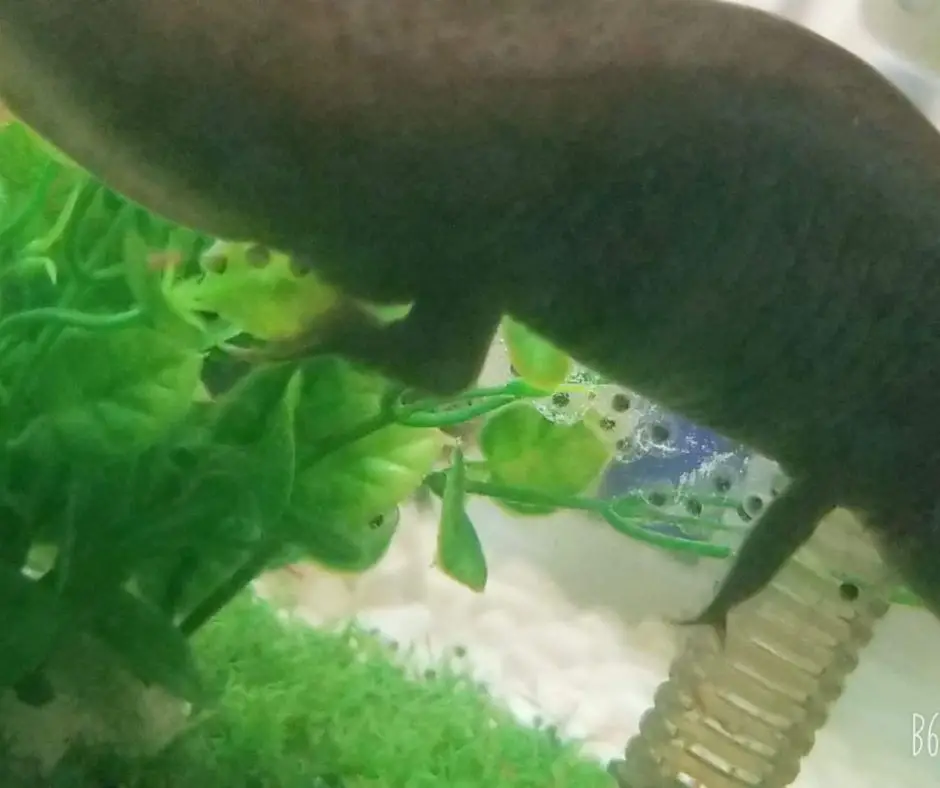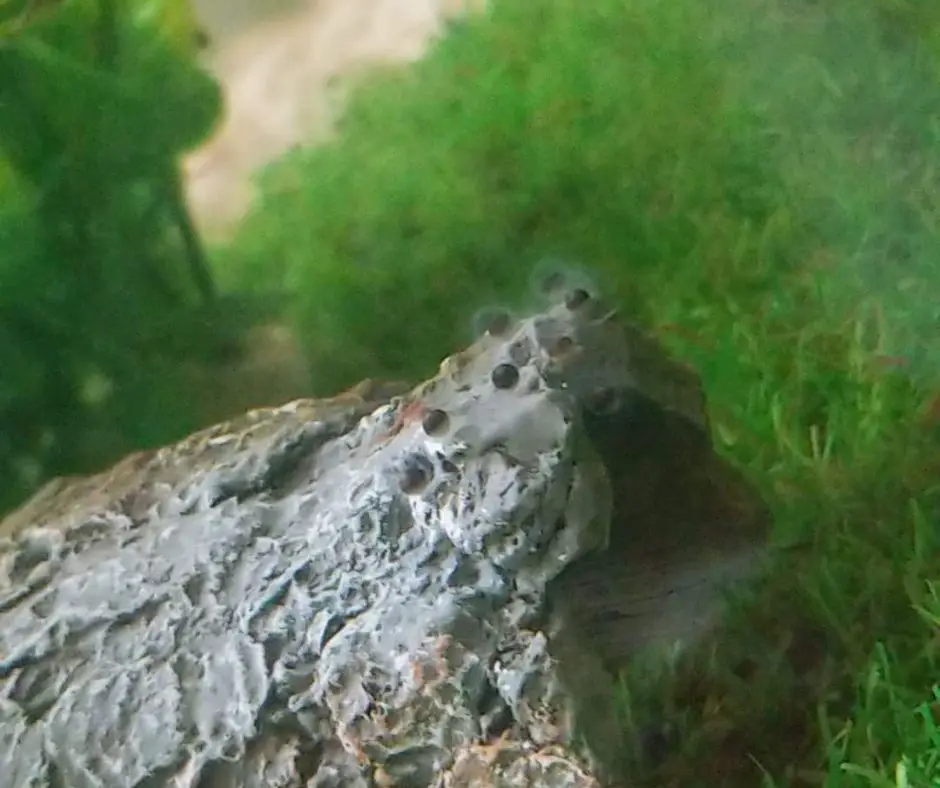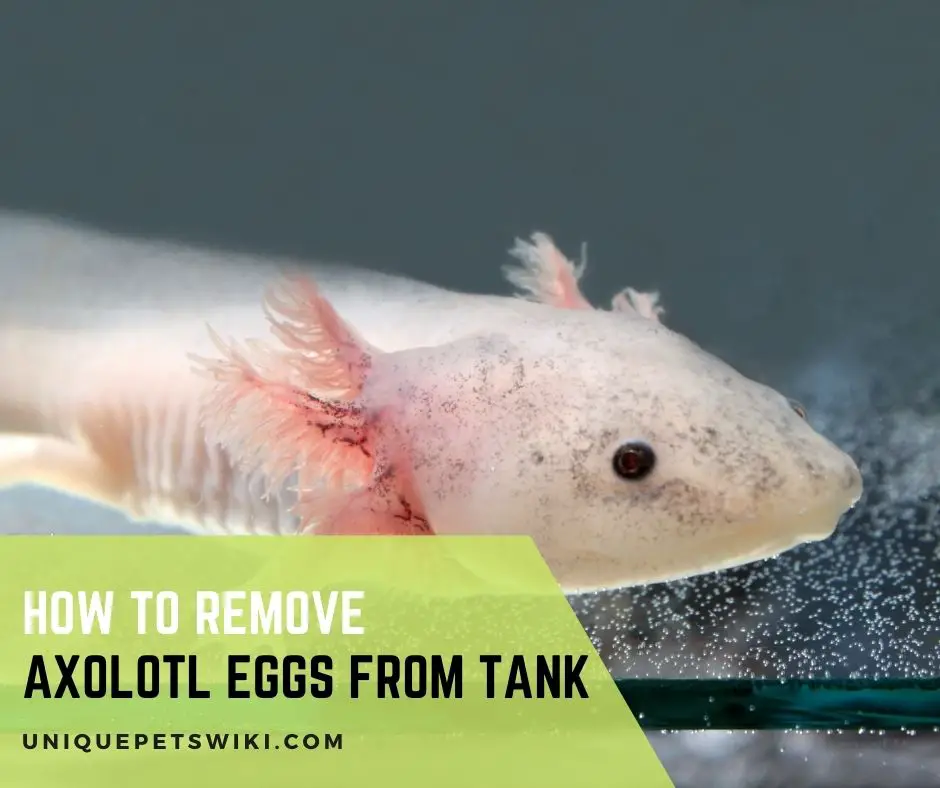Once your axolotl has laid eggs, it is important to consider the question? What should you do?
You may choose to remove the eggs and humanely kill them in a freezer or compost them by burying them in the soil. You could also incubate them separately to hatch them and observe the embryos.
This is because, once the eggs hatch, the adult axolotls – who often have cannibalistic tendencies – tend to eat the eggs and hatchlings. This makes egg removal from the tank rather important.
In this guide, we tell you all about what to do with the axolotl eggs and different ways of removing them from the tank.
Before we consider the methods for egg removal, let us take a look at how axolotl eggs look.
Contents
What Do Axolotl Eggs Look Like?
Most axolotl eggs look like jello-like blobs as they are surrounded by a gelatinous coating. Mostly, the eggs are white or black with a jelly-like covering. Some may be brownish and small in size.
Albino axolotls often lay white or colorless eggs. As the eggs grow, they tend to develop puffs of air around them.

How Do I Know If My Axolotl Egg Is Fertilized?
The size and colour of the eggs on your Axolotl indicate whether they have been fertilized or not. Here are some steps to help you determine if your axolotl’s eggs are fertilized:
- White spot – fertilized axolotl eggs will have a white spot on them whereas unfertilized eggs remain clear or opaque.
- Size: Fertilized eggs will have a bigger size than unfertilized eggs and will be noticeably black or white in colour with a protective goo encircling them. Additionally, Unfertilized eggs measure approximately 0.2 cm in diameter, while fertilized eggs measure approximately 1.1 cm in diameter.
- Other signs of development – Healthy axolotl eggs progressively change and darken in colour over time. Regular axolotls lay black eggs, while albino axolotls lay white eggs. Fertilized eggs will show signs of embryo development and may develop into larvae. These look tadpole-like with fins.
Do Axolotls Eat Their Eggs?
If you’re wondering whether your axolotl can eat eggs or their babies, the uncomfortable answer is yes. Axolotls are known for cannibalistic tendencies and could eat their eggs for the following reasons:
- Stress – axolotls can get stressed due to overcrowding of the tank or due to changes in water parameters. To handle the stress, they may turn to egg-eating for self-soothing.
- Sometimes, an undernourished axolotl may eat the eggs to receive protein and other nourishment from them.
- Sometimes just by accident, because axies eyesight is very poor.
How To Remove Axolotl Eggs From Tank

How you remove the axolotl eggs from the tank can depend on various factors. The most important factor is the purpose or reason behind the egg removal. You have several choices before you:
- Do you want to harvest the eggs and hatch them and observe them?
- Do you want to dispose them of humanely?
- Do you want to remove the axolotls from the tank to a separate tank and keep the eggs as is?
- Perhaps you can leave the eggs in the tank and let the adult axies care for them?
But before removing the eggs, you need to prepare the container:
- Take a large container and add clean, dechlorinated water to it.
- If you want the axolotl eggs to hatch, keep the water clean and maintain the temperature at 18-20 C or 64-68 F.
Now you can use one of the following three methods to remove the eggs.
Using a Turkey Baster
- If the eggs are on the plant, use a turkey baster, spatula, spoon, or forceps to remove them from the tank into a separate container.
- Use the forceps or turkey baster to gently scoop out the eggs from the plants or rocks into the container prepared above.
- You can also use a spatula or spoon for transferring the eggs. Be gentle and try not to damage or disturb the eggs.
Turkey Baster
- Round, silicone bulb is comfortable to hold from any angle
- Clear cylinder allows easy viewing of the contents and volume
- Easy to read standard and metric measurement markings
- Fits comfortably in hand, also works well for removing juices and liquid from pan
- Measures 11" (Color Black or White)
Last update on 2022-12-29 / Affiliate links / Images from Amazon Product Advertising API
Move The Plants to the Container
- You can also transfer the plants and rocks having the axolotl eggs to the container with dechlorinated water.
- Once the plants are placed into the container, you can gently brush off the eggs.
- Use a soft-bristled brush or sponge to gently clean the eggs from the plants’ surfaces
Aqueon LED MiniBow Kit with SmartClean Technology
- Equipped with SmartClean(TM) Technology to perform water changes in less than 2 minute
- Improve water quality for a happy, healthy fish
- Includes aquarium vessel, hood and elevated base, power filter, small filter cartridge, fish food, water conditioner and setup guide
- Great home for small fish
- For first time and experience fish keepers of all ages.Uses Aqueon Small Replacement Cartridge
Last update on 2022-12-29 / Affiliate links / Images from Amazon Product Advertising API
Using Your Hands
- Wash your hands with mild soap. Do not use harsh, scented soaps or hand sanitizers with alcohol. Avoid lotion-based cleaners.
- Using your hands, scoop the eggs into the prepared container.
You can choose to incubate the eggs or dispose them of.
How to Dispose Of The Unfertilized Eggs
- You can compost them or bury them in the soil.
- Alternatively, you may humanely choose not to fertilize them by placing them in the freezer. The cold temperature will kill the eggs
How to Care for Eggs Axolotl Until They Hatch
Raising axolotl eggs will also allow you to observe egg development as a fun science project. You can choose to move the axolotl eggs to a separate tank. This will prevent them from being eaten by cannibalistic adult axolotls. Here are the steps to care for the axolotl eggs:
Maintain Consistent Water Parameters
- Use dechlorinated water.
- Keep the water at a temperature of around 18-20°C (64-68°F). Use a heater with a thermostat if necessary to maintain a stable temperature.
- Maintain the pH at 7-7.5. Axies prefer slightly alkaline water
- Water hardness needs to be around 75-150 ppm.
- Ammonia and nitrites should be close to 0 ppm as anything above that can be toxic to axolotl eggs and larvae. Keep nitrates below 20 ppm.
- Provide oxygen – Keep the eggs ventilated and oxygenated using a fan around the tank. Alternatively, use a water stone or filter to provide bubbles to do this job.
Be Patient and Avoid Handling the Eggs
- Axolotl eggs can take about 2 weeks to hatch. Be patient and allow the eggs to hatch at their own pace.
- Do not touch or move the eggs unnecessarily. Doing so could hamper their development.
- Keep the water clean. Change the water every 3-4 days.
- You may observe the eggs and see the embryo developing.
Prepare for Hatching
- Make sure the hatching conditions are appropriate for the larvae including temperature and pH and other parameters as above.
- Once the eggs are close to hatching, you will see the appearance of larvae. You will also see them move.
- Buy the food needed for the larvae. We recommend buying newly hatched brinehrimp.
- If they are too crowded you can move them to other tubs or share them with those who want to keep them so they are well taken care of.
Conclusion
Once your axolotl has laid eggs you need to decide whether to remove them or leave them in the tank. This decision depends on whether you want to breed your axolotls on your own, allow the adults to care for their young, or simply dispose of the laid eggs humanely.
You can use a turkey baster, scoop, or a spoon to remove the eggs in a specially prepared container with dechlorinated water. You may also use your hands to scoop the eggs out, but make sure to wash them first.
We hope this guide helps you remove your axolotl eggs safely.


